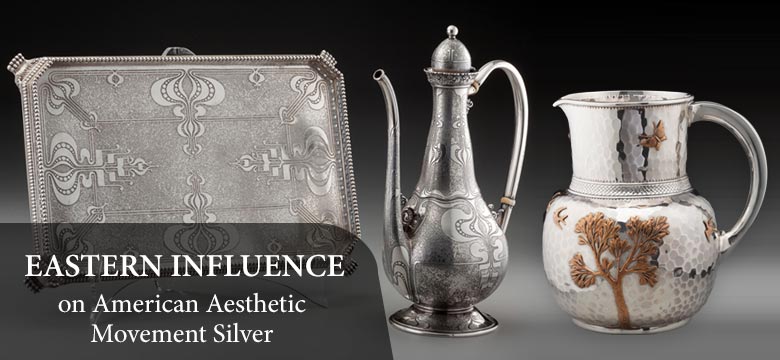
In our upcoming April 12 Silver and Objects of Vertu Signature Auction, we feature a strong selection of American Aesthetic Movement objects, including many prized mixed-metal lots embellished with copper and gold elements. These pieces illustrate the wide range of influences on Western decorative arts in the late 19th century and the desire to integrate these foreign influences into domestic spaces.
The Aesthetic Movement emerged in Britain and France in the 1860s, between the High Victorian and Arts and Crafts eras. Aesthetic designers and manufacturers promoted the production of objects of “visual harmony” that drew inspiration from simplified, often organic forms. Aestheticism rebelled against the Victorian notion that art should serve as a vessel to reinforce moral or social values (i.e. narrative/religious matter). Instead, the movement’s emphasis was placed on the owner’s ability to identify and respond to the elements that contributed to its collective beauty. Yet aestheticism wasn’t a complete rejection of the old, and designers often blended styles from varying periods and countries in the composition of a single piece. Specifically during this period, Western fascination with the Japanese aesthetic exerted a strong influence over decorative arts.

In 1854, Commodore Matthew Perry of the United States Navy ended Japan’s 220 year self-imposed period of seclusion, opening its ports to the West. In addition to commerce emanating from the country, the opening also allowed a more extensive transfer of Japan’s art, history, and social customs. English designer Christopher Dresser was influential in introducing the oriental motifs that strongly characterized the British Aesthetic Movement. Invited by the Japanese government in 1876 to study the Japanese craft traditions in the arts, Dresser remained in the country for four months visiting over 60 potteries, compiling thousands of photographs, and bringing hundreds of samples back to England for importers like Tiffany and Company and Londos of London. His book Japan: Its Architecture, Art and Art Manufactures, published in 1882, was widely disseminated in the U.S. and Europe, illuminating a sophisticated aspect of a culture previously unknown to the West. Dresser’s interpretations of Japanese geometry and illustrations in his ceramic, metalwork, and furniture designs was unlike popular contemporary revival movements. Instead of intending to convey historical accuracy, his objective was to bestow a pleasing viewing experience in each object.
The chief vehicle for the Aesthetic Movement’s spread in both the United States and Europe can be credited to international fairs and expositions. These events introduced the general public to advances in manufacturing and contemporary design, its awards designating arbiters of taste. Attendees were exposed to furniture, metalwork, ceramics, textiles, glass, and decorative arts from a variety of nations and periods. Dresser was enthralled with Sir Rutherford Adcock’s personal collection of Asian decorative arts at the 1862 International Exposition in London, and purchased several items for the newly formed South Kensington Museum. The Philadelphia Centennial Exposition of 1876 is credited by many historians as the formal introduction of aestheticism in America, spurning the movement’s popularity there among the middle classes.

The commercial mining of the Comstock Lode in the early 1870s coupled with the Panic of 1873 contributed to a gradual decline in the price of silver during the rise of the Aesthetic Movement in America. This created a plentiful supply and fertile buying environment for silver designers and manufacturers like Tiffany, Gorham, Whiting, Biddle and Company, and Reed and Barton. These companies featured Japanese-inspired designs on silver flatware and hollowware utilizing botanical, oceanic, and entomological motifs. Tiffany and Company enjoyed great success at the 1878 Exposition Universelle in Paris, where the firm was awarded the Grand Prix[i] for its exotic Japanesque mixed-metal wares. The firm’s “Conglomerate Vase” combined copper, silver, gold, and other metals in a radical demonstration of the master craftsmanship Tiffany was capable of performing. Indeed, the caliber of American silver displays was worthy of international acclaim as noted by Dresser: “…while in silver wares we must admit that we were fairly beaten, and that from a quarter which we least expected serious competition.”

Yet America was supreme in this branch of manufacture, and Elkington, Christofle of Paris, and others had to accept the humiliating, yet just, award of the jurors.[ii]” What is important to the understanding of American Aesthetic silver is the creativity and originality that Tiffany and Company personified in its pieces. Dresser spent several thousand pounds collecting objects for Tiffany while in Japan, and wrote specific labels on each piece he brought back explaining their artistic and design merits. Dresser himself was surprised that Tiffany actually considered some of his suggestions in drafting Japanesque wares and noted that “the firm named did not produce even a single imitation of any object thus acquired.[iii]” The Grand Prix award at the 1878 Exposition positioned Tiffany as the authority on American interpretation of Japanese motifs in silver and mixed metal media.
Tiffany’s inclusion of Eastern and oriental motifs during the time period was not coincidental. In addition to foundational business interests in selling the latest fashions, there were also pre-existing internal influences on the direction of design. Edward Chandler Moore was the son of John Chandler Moore and joined the firm in 1851, quickly rising to the directorship of its silver department. It was Edward who delivered the impetus to change Tiffany’s silver standard from coin (.900 purity) to the English sterling standard (.925 purity) in 1852. Moore was well-travelled, due to the company’s frequent participation in international expositions, and compiled an extensive library of books on decorative arts from around the world. In addition, he was an avid collector of ancient, medieval, oriental, and Islamic objects which he later bestowed to the Metropolitan Museum of Art.
When we consider exactly what design elements of a piece make American Aesthetic silver “Japanesque,” research indicates that this quality is expressed primarily in ornamentation and decoration, and not necessarily in form. A commonality between all makers of American aesthetic silver is the inclusion of hand-hammered textures and elongated forms—a departure from the grand floral, Classical Revival, and Rococo embellishments found on earlier wares. American aesthetic pieces illustrate a distinctly American advantage during this time period as mixed-metal techniques were prohibited by European assay laws. Artisans at Tiffany and Company adopted ornamental techniques (such as the inlaying of metal into another) from Japanese artisans, a technique found on many samurai sword handles in Moore’s personal collection. However, the shapes of hollowware were drafted separately from ornamentation. Tiffany and others drew inspiration from independent research on Islamic motifs and referenced British architectural elements of the Indo-Saracenic Revival. Even before historians attribute the introduction of aesthetic ideals in America, Moore had already used Saracenic forms in hollowware. A pear-shaped “Moresque” tea and coffee service was exhibited at the 1867 Paris Exposition Universelle[iv]. Later iterations of these forms were customized with applied Japanesque botanical and entomological decoration. However many pieces designed by Moore exhibit the forms and exercise of restraint so common to Japanese craft. The silver brush pot pictured below is typical in form of carved bamboo examples found in Japanese antiquity. The design was embellished with Indian latticework to the lower base and stylized triangulated feet.
Moore designed the firm’s Japanese flatware pattern in 1871 which consisted of die-punched implements featuring birds, chrysanthemums, and foliage to the handles styled in the Japanese taste. Gorham created a similar Japanese pattern that same year with pagoda-framed terminals housing chrysanthemum medallion, handles and stems with avian rousant and pseudo-character motifs. A variant of the pattern displays a bell-frame handle with a fan and insect motif to interior and bamboo stalk to stem. In 1874, Whiting Manufacturing Company’s Charles Osborne designed that company’s Japanese pattern, similar to Tiffany’s with a more ornamental bamboo-form stem. The popularity of bird rousants in flatware was so successful that other manufacturers drafted similar designs. Later interpretations of Tiffany’s original pattern by some companies bore too much resemblance, and the company filed injunctions against John Wendt, Bernard Beiderhase, and Wood and Hughes (in each case resulting in a ruling for Tiffany.[v]) Additionally, the rulings reinforced that Tiffany was the innovator behind Japanese imagery on American silver, due to Moore’s extensive research and appreciation of intercontinental design. Whiting’s later entry into Japanesque flatware nearly three years after Gorham and Tiffany illustrated that the company’s designers were familiar with, but not at the forefront of creating industry trends.


[i] The award consisted of one gold, one silver, and four bronze medals.
[ii] “Manufactures and Art,” The Furniture Gazette, March 1880, p.163
[iii] ibid
[iv] Pattern Book No. 2: 1500-2893, vol. 1 of 3 vols., Tiffany and Company Archives
[v] D. Albert Soeffing, “The Battle of the Birds: Japanese Patterns of the 1870’s’ in Silver Magazine, May/June 1995, pp. 18-23
By: Nathan Shults


Leave a Comment